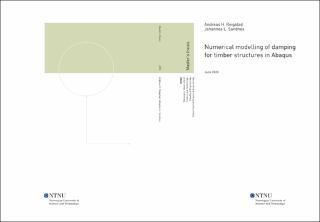| dc.contributor.advisor | Malo, Kjell Arne | |
| dc.contributor.author | Reigstad, Andreas H. | |
| dc.contributor.author | Sandnes, Johannes L. | |
| dc.date.accessioned | 2021-09-21T16:06:57Z | |
| dc.date.available | 2021-09-21T16:06:57Z | |
| dc.date.issued | 2020 | |
| dc.identifier | no.ntnu:inspera:56731605:22971477 | |
| dc.identifier.uri | https://hdl.handle.net/11250/2779996 | |
| dc.description.abstract | Demping er en egenskap som påvirker den dynamiske responsen til trekonstruksjoner. Det er imidlertid en vanskelig oppgave å representere virkelig demping numerisk. I denne oppgaven er numerisk modellering av demping for trekonstruksjoner undersøkt ved bruk av den kommersielle FE-programvaren Abaqus fra Simulia. Muligheter, begrensninger og egnethet av ulike dempingsmodeller har blitt vurdert.
Fritt opplagte 3D-bjelker og stive 2D-rammer har blitt modellert i ulike geometriske varianter, med ulike elementer og ulike matematiske dempingsmodeller. Disse inkluderer material og global Rayleigh-demping, i tillegg til konstruksjonsdemping (eng: «Structural damping»). Elementene inkluderer Euler-Bernoulli og Timoshenko bjelkeelement, et skallelement, et volumelement og et plant spenningselement. En viktig intensjon var å undersøke forskjellen mellom elementer som er skjærfleksible og ikke-skjærfleksible.
Spesifisering av materialdemping gjennom modulen for materialegenskaper gjør det mulig å tilordne ulike nivå av demping til ulike deler av de numeriske modellene. Kombinasjoner av material Rayleigh-damping og material konstruksjonsdemping (eng: «Structural damping») har blitt testet. Modeller med global Rayleigh-demping har også blitt undersøkt.
I noen tilfeller avviker både material og global demping fra det forventede ut ifra den matematiske formuleringen. Avvik var relatert til valg av programvarearkitektur og elementtyper, hvor de underliggende årsakene har blitt undersøkt, skjønt ikke fullt ut avdekket. For de skjærfleksible bjelkeelementene førte implementeringen av material Rayleigh-demping til en underestimering av dempingen i forhold til den matematiske formuleringen av Rayleigh-demping. Videre undersøkelser indikerte at mulige årsaker er relatert til formuleringen av Timoshenko-elementene og/eller etableringen av stivhetsmatrisen. Skjæreffekter ble også vurdert til å ha en påvirkning på avvikene. Resultatene peker også mot at egenfrekvensene blir underestimert for høye (tykke) bjelker modellert med skall- og volumelementer. | |
| dc.description.abstract | Damping is a property that influence the dynamic response of timber structures. However, representing real-world damping numerically is a challenging task. In this thesis, investigations of numerical modelling of damping for timber structures have been performed by use of the commercial FE-software Abaqus by Simulia. Possibilities, limitations and usefulness of different damping models have been evaluated.
Simply supported 3D beams and rigid 2D frames have been modelled with different geometrical configurations, different elements and different mathematical damping models. These include material and global Rayleigh damping, as well as structural damping. The elements include Euler-Bernoulli and Timoshenko beam elements, a shell element, a 3D solid (volume) element and a plane stress element. A major intention was to investigate the differences between non-shear-flexible and shear-flexible elements.
Specifying material damping through the material properties module allowed for assigning different damping levels to different parts of the numerical models. Combinations of material Rayleigh damping and material structural damping have been tested. Models with global Rayleigh damping have also been assessed.
In some cases, both material and global damping deviated from the expected with respect to the mathematical formulation. Deviations were related to the choice of software architecture and element types, for which underlying causes have been investigated, although they have not been fully revealed. For the shear-flexible beam elements, implementation of material Rayleigh damping was found to underestimate damping relative to the mathematical Rayleigh damping formulation. Further investigations indicated that possible causes are related to the formulation of the Timoshenko elements and/or the establishment of the stiffness matrix. Shear effects were also considered to have an influence on deviations. Results also points towards eigenfrequencies being underestimated for high (thick) beams modelled with shell and 3D solid elements. | |
| dc.language | | |
| dc.publisher | NTNU | |
| dc.title | Numerical modelling of damping for timber structures in Abaqus | |
| dc.type | Master thesis | |
